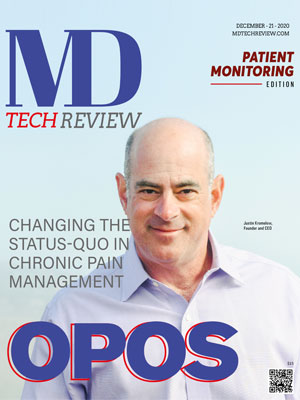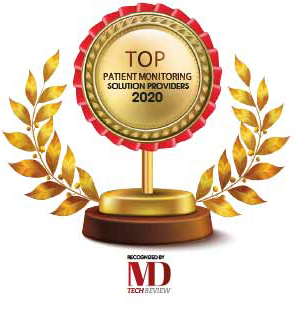Be first to read the latest tech news, Industry Leader's Insights, and CIO interviews of medium and large enterprises exclusively from MD Tech Review
Early Detection of Liver Disease at the Point of Care Can Halt or Reverse Liver Damage Among Hispanic/Latino Populations
 Jon Gingrich, CEO,Echosens North America
Jon Gingrich, CEO,Echosens North AmericaGlobally, the total number of people with diabetes will rise from ∼11 million in 2000 to almost 20 million in 2025. Hispanics are more likely than the general population to develop diabetes. It is estimated that 2.5 million, or 10.4% of Hispanic and Latino Americans aged 20 and older have diabetes. Hispanics also are more likely to have undiagnosed diabetes than non-Hispanic whites and non-Hispanic blacks.
Diabetes raises the risk of NAFLD, which is likely to increase from 83.1 million to 100.9 million by 2030, and NASH from 16.52 million to 27 million. A meta‐analysis reports that NAFLD prevalence was highest in Hispanics, intermediate in whites and lowest in blacks. Among patients with NAFLD, risk for progression to NASH was also higher among Hispanics.
NASH leads to inflammation and fibrosis, which can then develop into liver cirrhosis, primary liver cancer and sometimes death. Prevalent NASH cases are expected to increase 63% from 16.52 million to 27 million cases by 2030. Because liver fibrosis is a strong predictor of long-term mortality in patients with NAFLD, a growing number of healthcare stakeholders are adopting non-invasive tools to battle the liver disease epidemic.
Furthermore, the prevalence and costs of underdiagnosed liver disease is now tied to more than $100 billion in annual direct costs. Experts estimate that approximately 24% of U.S. adults have NAFLD and about 1.5-6.5% of U.S. adults have NASH, which can lead to advanced fibrosis, liver cancer, liver transplantation, increased risk of cardiovascular events and all-cause mortality.
Hispanic Groups Face Health Challenges
One study found that the demographics of patients seen at Federally Qualified Health Centers (FQHCs) from 2005 and 2014 have shifted, with the prevalence of young, low-income, uninsured or Medicaid-insured, racial and ethnic minorityAmericans increasing more rapidly than other demographic groups. Hispanic Americans represent the minority group with the largest growth rate, increasing from 11.2% in 2007 to 13.4% in 2014.
This is important because studies show that Hispanics and patients with diabetes are at greatest risk for both NAFLD and NASH, and the prevalence of both is higher in the Hispanic population. Those with Type 2 diabetes and high rates of liver fat are more likely to have progressive liver disease than those with Type 2 diabetes alone. The 2019 Standards of Medical Care in Diabetes issued by the American Diabetes Association recommend that patients with Type 2 diabetes or pre-diabetes and elevated liver enzymes or fatty liver on ultrasound should be screened for the presence of liver disease.
Non-Invasive Technology
Non-invasive technology (NIT) has earned a high level of recommendation form leading healthcare authorities around the world. In particular, vibration-controlled transient elastography (VCTE) technology, including liver stiffness measurement (LSM) by transient elastography (TE), controlled attenuation parameter (CAP) and spleen stiffness measurement (SSM), represent an additional NIT to further improve risk stratification and refine the risk of high-risk varices.
VCTE measures and monitorsliver disease across the liver care continuum for all population groups.For example, FibroScan is a VCTE tool thatcombines standardization, clinical performance and accessibility for early patient identification, either in primary care, diabetology clinic or liver clinic, and for advanced liver disease patient management, portal hypertension and hepatocellular carcinoma (HCC) risk stratification.
VCTE technology is key for detecting and monitoring for NAFLD/NASH, alcoholic liver disease (ALD), hepatitis C virus, including post sustained virologic response (PSVR), primary biliary cirrhosis (PBC)/primary sclerosing cholangitis (PSC) and autoimmune hepatitis (AIH), as well as in at-risk populations, such as patients with metabolic risk factors and/or harmful use of alcohol.
Early Detection Leads to Behavior Modification
Current approaches for identifying liver damage tend to be complicated, expensive and potentially wasteful. In contrast, VCTEoffers results and scores that are extremely helpful in providing additional information for clinicians in evaluating liver health. Armed with this tool and the data and information that it provides, clinicians can make decisions in real time at the point of care: a reliable, early identification of patients with fatty liver disease for proactive intervention and behavior change, including recommendations for diet and exercise that will lead to weight loss.
In many patients, a 5-7% decrease in body weight is associated with a reduction in liver fat and inflammation. This helps to slow liver disease progression. For those identified with liver fibrosis, these exams can also reduce reliance on more expensive and invasive diagnosis methods, such as painful liver biopsy. This saves time and resources for people who may not require further evaluation.
The most effective VCTE tools are small and portable, making them easy to use in the office or outpatient setting. Moreover, they can be operated by a medical assistant or technician, with results interpreted by the healthcare professional. These tools produce numerous measurements, rather than images, for simplified interpretation and consistency of measurement. This enables clinicians to monitor changes in liver tissue over time and share data with the patient to demonstrate progress or prompt lifestyle changes. Adopting a VCTE tool that is covered by Medicare, Medicaid and many insurance plans is a positive step toward improving health outcomes among Hispanic/Latino patient populations.
One study found that the demographics of patients seen at Federally Qualified Health Centers (FQHCs) from 2005 and 2014 have shifted, with the prevalence of young, low-income, uninsured or Medicaid-insured, racial and ethnic minorityAmericans increasing more rapidly than other demographic groups. Hispanic Americans represent the minority group with the largest growth rate, increasing from 11.2% in 2007 to 13.4% in 2014.
This is important because studies show that Hispanics and patients with diabetes are at greatest risk for both NAFLD and NASH, and the prevalence of both is higher in the Hispanic population. Those with Type 2 diabetes and high rates of liver fat are more likely to have progressive liver disease than those with Type 2 diabetes alone. The 2019 Standards of Medical Care in Diabetes issued by the American Diabetes Association recommend that patients with Type 2 diabetes or pre-diabetes and elevated liver enzymes or fatty liver on ultrasound should be screened for the presence of liver disease.
Non-Invasive Technology
Non-invasive technology (NIT) has earned a high level of recommendation form leading healthcare authorities around the world. In particular, vibration-controlled transient elastography (VCTE) technology, including liver stiffness measurement (LSM) by transient elastography (TE), controlled attenuation parameter (CAP) and spleen stiffness measurement (SSM), represent an additional NIT to further improve risk stratification and refine the risk of high-risk varices.
VCTE measures and monitorsliver disease across the liver care continuum for all population groups.For example, FibroScan is a VCTE tool thatcombines standardization, clinical performance and accessibility for early patient identification, either in primary care, diabetology clinic or liver clinic, and for advanced liver disease patient management, portal hypertension and hepatocellular carcinoma (HCC) risk stratification.
VCTE technology is key for detecting and monitoring for NAFLD/NASH, alcoholic liver disease (ALD), hepatitis C virus, including post sustained virologic response (PSVR), primary biliary cirrhosis (PBC)/primary sclerosing cholangitis (PSC) and autoimmune hepatitis (AIH), as well as in at-risk populations, such as patients with metabolic risk factors and/or harmful use of alcohol.
Early Detection Leads to Behavior Modification
Current approaches for identifying liver damage tend to be complicated, expensive and potentially wasteful. In contrast, VCTEoffers results and scores that are extremely helpful in providing additional information for clinicians in evaluating liver health. Armed with this tool and the data and information that it provides, clinicians can make decisions in real time at the point of care: a reliable, early identification of patients with fatty liver disease for proactive intervention and behavior change, including recommendations for diet and exercise that will lead to weight loss.
In many patients, a 5-7% decrease in body weight is associated with a reduction in liver fat and inflammation. This helps to slow liver disease progression. For those identified with liver fibrosis, these exams can also reduce reliance on more expensive and invasive diagnosis methods, such as painful liver biopsy. This saves time and resources for people who may not require further evaluation.
The most effective VCTE tools are small and portable, making them easy to use in the office or outpatient setting. Moreover, they can be operated by a medical assistant or technician, with results interpreted by the healthcare professional. These tools produce numerous measurements, rather than images, for simplified interpretation and consistency of measurement. This enables clinicians to monitor changes in liver tissue over time and share data with the patient to demonstrate progress or prompt lifestyle changes. Adopting a VCTE tool that is covered by Medicare, Medicaid and many insurance plans is a positive step toward improving health outcomes among Hispanic/Latino patient populations.



